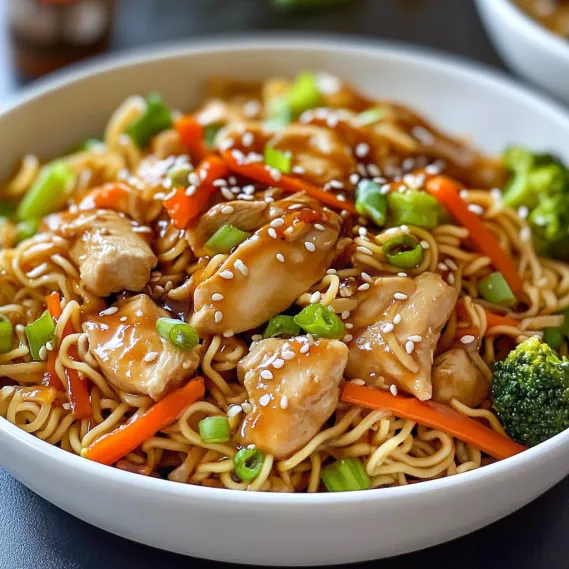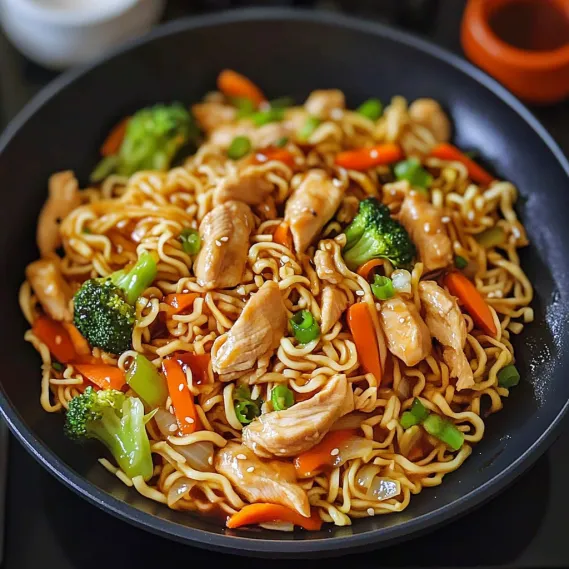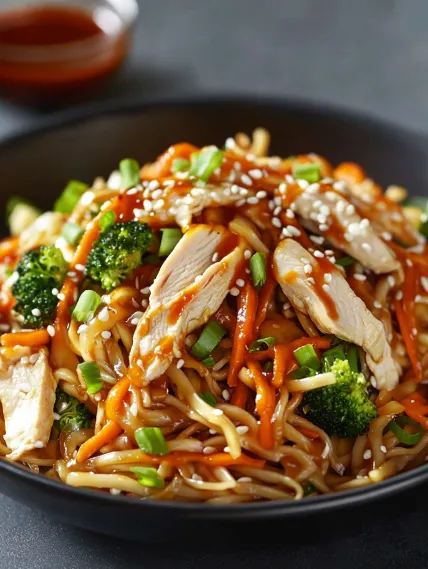 Pin
Pin
This hearty Chicken Yakisoba transforms simple ingredients into a restaurant-quality meal in just 35 minutes. The combination of tender chicken, crisp vegetables, and chewy noodles bathed in a sweet-tangy sauce creates a dish that balances flavors and textures perfectly.
I first made this yakisoba on a busy weeknight when I needed something fast yet satisfying. My family loved it so much that it quickly became our go-to alternative to takeout. The combination of textures and flavors creates that authentic Japanese street food experience right at home.
Ingredients
- Cabbage: Provides essential crunch and mild sweetness that absorbs the sauce beautifully. Look for firm heads with crisp leaves.
- Yellow onion: Offers aromatic sweetness when cooked. Choose medium-sized onions with tight papery skin.
- Carrots: Add natural sweetness and color. Select firm bright orange carrots for best flavor.
- Broccoli: Contributes nutritional value and texture. Choose tight florets with vibrant green color.
- Fresh ginger: Delivers essential aromatic heat. Look for plump hands with smooth skin.
- Chicken breast: Provides lean protein. Choose hormone-free options for best quality.
- Ramen noodles: Give this dish its authentic texture. Discard flavor packets and just use the noodles.
- Soy sauce: Forms the salty umami base of the sauce. Use low-sodium variety if preferred.
- Worcestershire sauce: Adds complex tanginess. The authentic Japanese version includes tamarind and fish elements.
- Ketchup: Provides tomato sweetness and thickness. Use a natural brand without high fructose corn syrup.
- Sriracha: Adds customizable heat. Adjust amount based on your family's spice preference.
- Sugar: Balances the salty and tangy elements. Brown sugar can be substituted for deeper flavor.
How To Make Easy Homemade Chicken Yakisoba
- Prep All Ingredients:
- Gather all ingredients before beginning. This ensures even cooking and prevents burning more delicate items while chopping others. Cut vegetables consistently in size for even cooking. Slice chicken against the grain for maximum tenderness.
- Infuse The Oil:
- Heat your skillet properly before adding oil. The oil should shimmer but not smoke. Add ginger immediately and stir constantly to prevent burning. This critical step infuses the aromatic compounds into the oil that will flavor the entire dish.
- Cook The Protein:
- Add chicken in a single layer without overcrowding the pan. Allow it to develop some color before stirring. Cook completely through but avoid overcooking which can make it tough. The chicken should be just opaque throughout with slight browning.
- Sauté Vegetables:
- Add all vegetables at once and toss frequently. The key is to maintain some texture rather than fully softening them. Vegetables should retain slight crispness when done. The cabbage will release moisture that helps prevent sticking.
- Cook The Noodles:
- Boil water in a separate pot while vegetables cook. Watch noodles carefully as they cook quickly and can become mushy if overcooked. Drain immediately and toss with sesame oil which adds flavor and prevents clumping.
- Create The Sauce:
- Mix sauce ingredients in a separate bowl until sugar completely dissolves. Taste and adjust seasonings according to preference. The sauce should balance sweet, salty, tangy and spicy elements harmoniously.
- Combine Everything:
- Pour sauce evenly over the skillet contents. Fold in noodles gently to avoid breaking them. Allow everything to simmer briefly so flavors meld and sauce thickens slightly. The finished dish should be moist but not swimming in sauce.

The secret to exceptional yakisoba lies in the balance of the sauce. I discovered this perfect ratio after years of experimentation. My grandmother always said that good cooking is about finding harmony between contrasting flavors. This sauce captures that philosophy perfectly with its blend of sweet, salty, tangy and spicy elements coming together in perfect balance.
Authentic Japanese Variations
Traditional Japanese yakisoba often includes different seasonings such as oyster sauce, bonito flakes, and aonori seaweed powder. While this recipe adapts ingredients for American kitchens, the essence remains authentic. In Japan, yakisoba is popular street food served at festivals and often comes topped with pickled ginger and mayonnaise. Vendors cook it on large flat griddles called teppan, creating a slight char that enhances flavor.
Storage And Reheating
Refrigerate leftovers in airtight containers for up to 4 days. The flavors actually develop and improve overnight as the sauce penetrates the ingredients more deeply. To reheat, add a splash of water to prevent dryness and warm gently in a covered skillet over medium heat. Avoid microwave reheating which can make the noodles rubbery. For meal prep, consider storing components separately and combining just before reheating for best texture.

Ingredient Substitutions
The beauty of yakisoba lies in its adaptability. Swap chicken for thinly sliced beef, pork, tofu, or shrimp based on preference. For a vegetarian version, double the vegetables and add mushrooms for umami depth. The vegetable mix is flexible too. Use what you have on hand. Bell peppers, snow peas, bean sprouts, and spinach all work beautifully. For gluten free diets, use rice noodles and tamari instead of soy sauce. The sauce can be customized with honey instead of sugar or coconut aminos instead of soy sauce.
Recipe FAQs
- → Can I use a different type of noodle?
Yes, you can substitute ramen noodles with udon, soba, or even spaghetti. Adjust cooking time accordingly for the noodle type.
- → What vegetables can I add or swap?
You can substitute or add vegetables like bell peppers, snap peas, mushrooms, or zucchini for more variety.
- → Is it possible to make this dish vegetarian?
Absolutely! Replace the chicken with tofu, tempeh, or additional vegetables for a vegetarian version. Use a vegetarian-friendly Worcestershire sauce.
- → How do I prevent the noodles from sticking together?
Toss the cooked noodles with sesame oil or a small amount of vegetable oil immediately after draining to prevent sticking.
- → Can the sauce be made less spicy?
Yes, you can reduce or omit the sriracha sauce for a milder flavor. Add a bit more sugar if you prefer a sweeter sauce.
- → Can I prepare this dish in advance?
You can prepare and chop the vegetables, cook the noodles, and mix the sauce ahead of time. Combine them just before serving for the best texture and flavor.
- → What protein substitutes work well in this dish?
You can substitute the chicken with shrimp, beef, or even scrambled eggs for a different variation.
